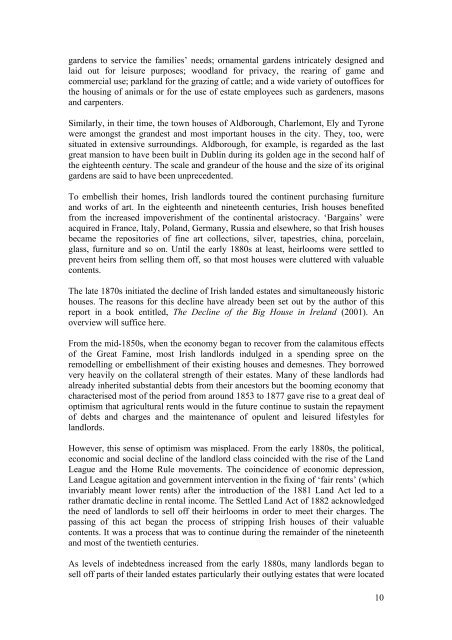A Future for Irish Historic Houses - Irish Heritage Trust
A Future for Irish Historic Houses - Irish Heritage Trust
A Future for Irish Historic Houses - Irish Heritage Trust
Create successful ePaper yourself
Turn your PDF publications into a flip-book with our unique Google optimized e-Paper software.
gardens to service the families’ needs; ornamental gardens intricately designed and<br />
laid out <strong>for</strong> leisure purposes; woodland <strong>for</strong> privacy, the rearing of game and<br />
commercial use; parkland <strong>for</strong> the grazing of cattle; and a wide variety of outoffices <strong>for</strong><br />
the housing of animals or <strong>for</strong> the use of estate employees such as gardeners, masons<br />
and carpenters.<br />
Similarly, in their time, the town houses of Aldborough, Charlemont, Ely and Tyrone<br />
were amongst the grandest and most important houses in the city. They, too, were<br />
situated in extensive surroundings. Aldborough, <strong>for</strong> example, is regarded as the last<br />
great mansion to have been built in Dublin during its golden age in the second half of<br />
the eighteenth century. The scale and grandeur of the house and the size of its original<br />
gardens are said to have been unprecedented.<br />
To embellish their homes, <strong>Irish</strong> landlords toured the continent purchasing furniture<br />
and works of art. In the eighteenth and nineteenth centuries, <strong>Irish</strong> houses benefited<br />
from the increased impoverishment of the continental aristocracy. ‘Bargains’ were<br />
acquired in France, Italy, Poland, Germany, Russia and elsewhere, so that <strong>Irish</strong> houses<br />
became the repositories of fine art collections, silver, tapestries, china, porcelain,<br />
glass, furniture and so on. Until the early 1880s at least, heirlooms were settled to<br />
prevent heirs from selling them off, so that most houses were cluttered with valuable<br />
contents.<br />
The late 1870s initiated the decline of <strong>Irish</strong> landed estates and simultaneously historic<br />
houses. The reasons <strong>for</strong> this decline have already been set out by the author of this<br />
report in a book entitled, The Decline of the Big House in Ireland (2001). An<br />
overview will suffice here.<br />
From the mid-1850s, when the economy began to recover from the calamitous effects<br />
of the Great Famine, most <strong>Irish</strong> landlords indulged in a spending spree on the<br />
remodelling or embellishment of their existing houses and demesnes. They borrowed<br />
very heavily on the collateral strength of their estates. Many of these landlords had<br />
already inherited substantial debts from their ancestors but the booming economy that<br />
characterised most of the period from around 1853 to 1877 gave rise to a great deal of<br />
optimism that agricultural rents would in the future continue to sustain the repayment<br />
of debts and charges and the maintenance of opulent and leisured lifestyles <strong>for</strong><br />
landlords.<br />
However, this sense of optimism was misplaced. From the early 1880s, the political,<br />
economic and social decline of the landlord class coincided with the rise of the Land<br />
League and the Home Rule movements. The coincidence of economic depression,<br />
Land League agitation and government intervention in the fixing of ‘fair rents’ (which<br />
invariably meant lower rents) after the introduction of the 1881 Land Act led to a<br />
rather dramatic decline in rental income. The Settled Land Act of 1882 acknowledged<br />
the need of landlords to sell off their heirlooms in order to meet their charges. The<br />
passing of this act began the process of stripping <strong>Irish</strong> houses of their valuable<br />
contents. It was a process that was to continue during the remainder of the nineteenth<br />
and most of the twentieth centuries.<br />
As levels of indebtedness increased from the early 1880s, many landlords began to<br />
sell off parts of their landed estates particularly their outlying estates that were located<br />
10


